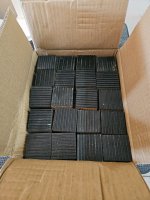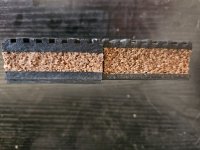I received a batch of 7815 that only gives out 14,6 volt
Depending on which manufacturer of 7815's you bought from, and depending on the suffix (7815B , 7815C , etc) ... the datasheet guaranteed output voltage may not be precisely 15.0000 volts. Here's the output voltage guarantees printed on the 7815B datasheet from OnSemiconductor. Lucky for you, Wayne Colburn was extremely familiar with these datasheets when he designed the Pearl 3 circuitry. Wayne isn't surprised that some of your 7815's put out 14.4 volts ... he expected that.
_
Attachments
The only odd thing I'm aware of is that for R27, I get the lowest, but still distortiony audible output at 680R (2.78v). This seems like a lot of resistance since the kit shipped with a 220R as standard (at which value, I'm seeing far too much voltage and huge amounts of distortion).
Does this indicate anything?
You are getting audible distortion? I do know that adjusting (or anything to do in general with) R27 isn't contributing to it in any way. The error is elsewhere.
Yep. I know the feeling. I just brought back a few LP from my record collection from overseas. I wish I had taken more of them. 50yo now unobtanium but basically still brand new. The sound quality is quite simply magnificent! They will return home when I retire and move back.@tonyEE and @grataku :
Yesterday I was loading some new/used vinyl on the player and I kept thinking "not knowing if this is going to be a keeper or not is fun." With a CD you drop it in and play and expect perfection. But with a 1960s jazz record there are an infinite number of playback feelings.
So, when you get near perfection it's time for a lap snuggle with that favorite spaniel, right? Got one of those yesterday with the closest to perfect album I have yet encountered, the 2022 reissue of "Workin' with the Miles Davis Quintet" Prestige CR00608. Told Boydk about this and, of course, he had one of the original pressings from 1964.
If you haven't heard this one give yourself a treat and load it up...
Thanks Mark... and yes... I´m familiar with the spec´s.Depending on which manufacturer of 7815's you bought from, and depending on the suffix (7815B , 7815C , etc) ... the datasheet guaranteed output voltage may not be precisely 15.0000 volts. Here's the output voltage guarantees printed on the 7815B datasheet from OnSemiconductor. Lucky for you, Wayne Colburn was extremely familiar with these datasheets when he designed the Pearl 3 circuitry. Wayne isn't surprised that some of your 7815's put out 14.4 volts ... he expected that.
_
It was more to point out, that even with regulators giving +14.6 and -15.0 volt, the Pearl-3 works flawlessly 😉
My AT was sealed.Boydk: Raised the issue of "new" cartridge status above and would like to know if AT sends out cartridges in sealed containers. Denon and Ortofon do, Hana does not. Have received one Hana cartridge sold to me as new that was clearly used and another that was questionable. Without the correct microscope it's hard to determine the actual state of the needle. Are there any other ways to ensure you are getting what you paid for?
Russellc
Did you check whether the transistors that were mounted the wrong way are still ok?Thanks for the guidance. I'll go back and recheck everything.
AkimoSD: Boydk's astute post above centers in on the most telling symptom you have related: the distortion is the same on both boards. This suggests that either you have made the same mistake on each PCB (same misplaced resistor value, e.g.) or that a common outside factor is causing the problem. These outside factors would include the PSU, wiring, case, terminations, and grounding.
If you have another bipolar PSU at 18+ vdc this would be a good time to try it out and wire it directly into one of the main boards. Similarly, I would check the positive portions of your RCA terminals for any looseness and/or indications of melting. Feeling the wires for looseness at end connecting points is also helpful.
Let us know when and how you have solved the problem as we are, of course, intrigued by your dilemma.
If you have another bipolar PSU at 18+ vdc this would be a good time to try it out and wire it directly into one of the main boards. Similarly, I would check the positive portions of your RCA terminals for any looseness and/or indications of melting. Feeling the wires for looseness at end connecting points is also helpful.
Let us know when and how you have solved the problem as we are, of course, intrigued by your dilemma.
As already mentioned by 6L6 this should not be critical so if the distortion changes with R27 value this could indicate that your issue is in this area....... The only odd thing I'm aware of is that for R27, I get the lowest, but still distortiony audible output at 680R (2.78v). This seems like a lot of resistance since the kit shipped with a 220R as standard (at which value, I'm seeing far too much voltage and huge amounts of distortion).
Does this indicate anything?
The LED should act like a zener and give constant voltage across Q6/Q7 base. Is it possible that there is damage to the LED when the transistors were incorrectly mounted?
I would carefully check voltage across D1 R23 and R24 and verify that R25/R26 and that R23/R24 measure correct values.
@bentconvert : On your advice ordered a lifetime supply of acoustic insulators from Supply House at their most reasonable price of $28 for 100. JPeg below shows how they come. Will be using these for three turntables, larger speakers, studio monitors, and on and on. Thanks again for your recco and knowledge. They are, btw, very slightly different from the ones on Amazon -- the rubber pads are just a bit less thick and the finishing a bit more casual. But for isolation purpose they look fine.
Attachments
Will there be another run of chassis from modushop?
Check our website: they can be purchased again
@bentconvert : On your advice ordered a lifetime supply of acoustic insulators from Supply House at their most reasonable price of $28 for 100. JPeg below shows how they come. Will be using these for three turntables, larger speakers, studio monitors, and on and on. Thanks again for your recco and knowledge. They are, btw, very slightly different from the ones on Amazon -- the rubber pads are just a bit less thick and the finishing a bit more casual. But for isolation purpose they look fine.
The rubber and cork isolation pads shown likely are very solid and unyielding under the weight of most turntables. They are designed to isolate heavy vibrating equipment like a 300 pound power transformer.
Think of the isolation pad or foot as a spring, to be effective it needs to squish or yield a bit under the weight of the plinth base and turntable.
Thanks DT
Looking for a double check.
measuring across R27 gives 2.34V (L ch.) & 2.37V (R ch.).
So Q9 bias is ~10mA.
Found some 470R 1/4W in the bin. Good enough to get close to 5mA?
Other option is a 1kR but that'd be closer to the 2mA bottom end.
measuring across R27 gives 2.34V (L ch.) & 2.37V (R ch.).
So Q9 bias is ~10mA.
Found some 470R 1/4W in the bin. Good enough to get close to 5mA?
Other option is a 1kR but that'd be closer to the 2mA bottom end.
6sX7: 470 ohms is fine -- gets you right to 4.9mA. Have spent some time matching the mA between the 2 boards and while it might be fastidious to do this, not sure it makes much difference as long as the value is between 3 and 5. Ordered values between 400 and 700 ohms from Digikey to do this and its nice to have them around.
Yes, I had this same thought.Think of the isolation pad or foot as a spring, to be effective it needs to squish or yield a bit under the weight of the plinth base and turntable.
SO...
It's fairly easy to replace the Amazon ones with the Supply House ones and see the effect upon the problem: the VPI/Hana ML match that produces a very slight hum.
The good news is that both isolators remove this hum. To get the best result I tested with the very quietist vinyl I have ever heard (by a bunch) -- the new German pressing of Ronstadt's first 4 recordings for Asylum. This was offered as a Record Sale Day this year. Curiously, it has not been the hit I was expecting. Has sold well but is still available at the original RSD price ($100). It is so quiet that you keep thinking you are listening to a CD.
Attached is a photo showing the two isolators. More rubber and less cork in the Amazon one. For heavier speakers I am going to use the Supply House version. You can press on the cork and feel it compress in both. Some new speakers that will arrive next May are 250 lbs each -- this will be ideal for the Supply House isolators.
My conclusion is that both have value for audio purpose.
And, btw, the VPI TT is one heavy beast -- close to 80 lbs.
Attachments
Another thing to try is to cut the isolation pads into smaller pieces. It is a pounds per square inch thing.
Thanks DT
Thanks DT
Perhaps taper or bevel the four sides to have a more flexible top or bottom however you orient it. I use the blue ones for everything, and I'll try out my bevel idea. Off-topic aplol0gies.
Skip
Skip
Put in the 470R. Left Channel @ 2.73V; Right Ch @ 2.79 = 5.8mA and 5.9mA respectively. A little high but good enough? Or time to order some >=500R?
The VPI issue is discussed throughout the web and BoydK was kind enough to send me several references. All TTs deal with the motor/platter connection and potential noise resulting from those two interacting. VPI takes the approach with the Prime of separating the two. Some cartridges (not all) read the motor vibration as a soft hum that appears once the needle is dropped on the record.
In order to remove this hum, it is necessary to isolate the motor from the platter. The best way is to put the motor on one support and the platter on a different one.
A close second is simply to isolate the energy of the motor and, additionally, isolate the platter/TT.
The Supply House isolators do this splendidly, with no physical alterations, and at the attractive price of $2.24.
Works for me...
In order to remove this hum, it is necessary to isolate the motor from the platter. The best way is to put the motor on one support and the platter on a different one.
A close second is simply to isolate the energy of the motor and, additionally, isolate the platter/TT.
The Supply House isolators do this splendidly, with no physical alterations, and at the attractive price of $2.24.
Works for me...
- Home
- Amplifiers
- Pass Labs
- Pearl 3 Burning Amp 2023


